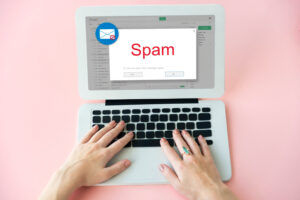
Source: Freepik
The spam folder – that place to which undesired emails are banished. This is exactly what the term “spam” refers to: e-mails that you don’t want to receive, which nonetheless keep finding their way into our inbox. Generally, the spam folder is a preset folder provided by the e-mail client, into which unsolicited e-mails are automatically moved with the help of anti-spam software. In fact, most of the time this sorting out works quite well.
How does the anti-spam software detect spam?
Every anti-spam software works slightly differently. The software rates incoming messages according to various criteria and parameters, which are embedded in a spam score system. The analysis of a message then results in a certain spam score. Elements that have a negative influence on the spam score are, for example, HTML emails, URLs and embedded images with URLs behind them. Certain words and phrases that are generally regarded as unserious (e.g. “TOP offer!”) can also lead to a high spam score. An aggressive sending frequency of the sender can also trigger software to mark sent e-mails as spam. In this case, the sender’s e-mail address is also examined more closely. However, as is often the case, no software is foolproof! Even important e-mails could end up in the spam folder.
Help! Important RWTH e-mails are ending up in my spam folder!
In our everyday lives, we often forget about the spam folder. We tend to ignore it simply because of how unbelievably practical it can be. No one wants to be overwhelmed by 100 emails about dubious inheritances from Nigeria, fake dream jobs or the supposed dream girl in your neighbourhood when opening their inbox. But even important e-mails can get lost in our spam folder from time to time. When sending important emails, the sender can try to follow the criteria mentioned above to avoid being marked as spam. At the IT Center, for example, we have adopted the BSI guidelines (german only), among others, which state that an email should first be displayed as plain text by default. However, the sender has no influence upon how the anti-spam software will evaluate the e-mail, as this evaluation depends on the receiving mail system.
What can I do to avoid missing important e-mails?
Anti-spam software often simplifies our lives. However, if you don’t want to miss anything, you should take a look at your spam folder from time to time. Unfortunately, there is no way to avoid this inconvenient process entirely. However, most email clients allow us to create so-called blacklists and whitelists. In these lists, we can explicitly block or allow certain content or senders. If certain content and senders are on the whitelist, they will never be moved to the spam folder. If you notice that certain emails mistakenly keep ending up in your spam folder, you may be able to fix the problem by adding them to the whitelist. The same applies with the help of a blacklist for content that is overlooked by the software but which you would like to banish to your spam folder.
In the RWTH Mail App (OWA), you can access your options under the “Settings” menu. You have several options that allow you to get the most out of your mailbox in just a few clicks. You can, for example, set inbox and clean-up rules. You can specify certain rules, such as the occurrence of certain words. From there, you can perform actions such as marking, moving or even deleting the e-mail in question. Under the option “Accounts – Block or allow” you can also block or allow senders. Under “Block or allow” you can also switch off the spam detection completely if necessary. Use the right settings to make sure you don’t miss any important e-mails in the future!
Responsible for the content of this article is Stéphanie Bauens.





Hallo sehr schönes und übersichtlicher Beitrag wo gute Tipps stehen und solche Spam Ordner umgehen kann.
Hallo Jan,
vielen Dank für das positives Feedback! Dann drücken wir mal die Daumen, dass wir die Tipps so selten wie nur möglich befolgen müssen 🙂
Viele Grüße,
das IT Center Blog Team